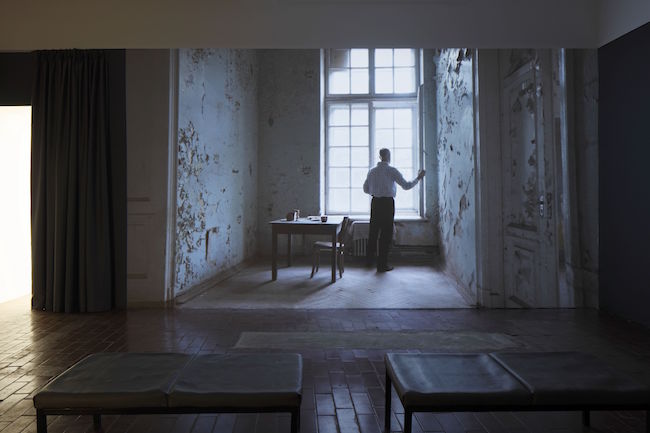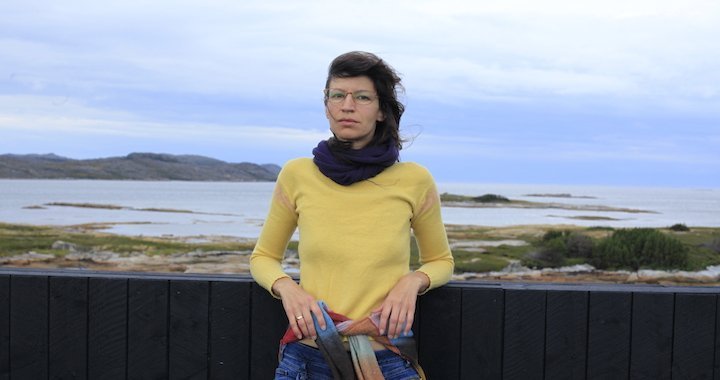
Solitude is very necessary
A conversation with Ieva Epnere, shortlisted for the Purvītis Prize 2019
20/03/2019
Ieva Epnere is one of the most vivid personalities in today’s contemporary Latvian art scene, and her chosen form of expression is photography and video. Although Epnere first studied textile art at the Art Academy of Latvia (for which she received her bachelor’s degree in 2001), by her second year of studies she had realised that she actually wanted something else. ‘I visited the studio of the photographer Andrejs Grants – it was the first time I had really “cheated” on textile art. And I was hooked. But if I look further back, I do remember my grandfather’s small wooden box full of little photographs (about 5 x 7 cm in size), which he himself had taken and also developed. I always liked to look at them – I was transfixed by them. I also liked to clip out pictures from magazines (my mom had given me subscriptions to cinema magazines) and I would paste them into a notebook. So, this interest in images and films was always there. My uncle also photographed a lot – he even gave me his Zenit brand camera’. Unsurprisingly, Epnere went on to obtain a master’s degree from the Department of Visual Communication, and then continued her studies at HISK in Ghent, Belgium.
Epnere is an internationally active artist: she regularly takes part in various art residency programmes around the world; participates in international group exhibitions, including How to Live Together at Kunsthalle Wien, and the 6th Moscow International Biennale; has had solo shows at Fogo Island Gallery in Canada, at HIT Gallery in Bratislava, and at the Zachęta Project Room in Warsaw; and has several times shown her works at the International Short Film Festival Oberhausen and at the Moscow International Experimental Film Festival, as well as elsewhere.
View from the exhibition Sea of Living Memories at the kim? Contemporary Art Centre (08.12.2016.–15.01.2017.). Photo: Ansis Starks
In 2016, Epnere had her first solo exhibition in the US – Sea of Living Memories, commissioned by New York City’s art exhibition space Art in General – which took place while she was participating in a two-month residency at the International Studio & Curatorial Program in New York (for which she had been sponsored by the kim? Residency Award). Sea of Living Memories was subsequently shown at the kim? Contemporary Art Centre in Riga, for which Epnere was then selected as a nominee for the Purvītis Prize 2019. Sea of Living Memories is a story about Latvia’s difficult Soviet past and its relationship with the present. The core of the work is deeply private: Epnere’s own family and experiences, and the attendant emotions that are always there in the background. Epnere was born in the city of Liepāja, and her parents still live there; in order to capture all of the possible colour nuances of the sea, which is prominently featured in the work, Epnere shot film on the coast of Liepāja from February 2016 until late summer. The sea is a symbol – some things it can hide, some it can wash up onto shore.
It would be fantastic if a person could live two lives at once. Then I’d be together with my family in one life, while in the other I’d be going off on my creative journeys. When I first went to Canada two years ago, for an artist residency on Fogo Island, I learned about the photographer Edith S. Watson, born in 1861 as the fourth child to an American family. She and her sister, Amelia, who would also be her lifelong best friend, were watercolour artists. In the beginning, they travelled throughout New England, displaying and selling their paintings. Later, Edith continued on her journeys alone. In the 1890s she turned to photography, and for the next forty years would spend the summer months in Canada (Newfoundland and Labrador), taking pictures of country folk (mostly women). She sold these photographs to newspapers and magazines, and made her living as a photojournalist – at a time when the term for the profession didn’t even exist yet. I am fascinated by powerful people and their life stories; I feel a kinship with them. I am a mother to two daughters; they are still quite young and so they dictate my life rhythm, so, for now, I cannot allow myself to go on lengthy, far-off journeys. I can tear myself away for a month, although I usually do take the girls with me when I go on a residency. Nevertheless, from time to time, solitude is very necessary for a creative person.
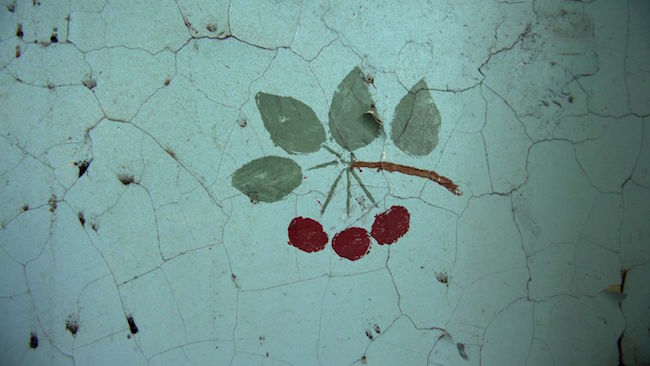
Ieva Epnere. “Potom” (“Later”, still from the video)
You have numerous works that were created while staying in assorted corners of the world. They are always very closely linked to your specific location – sometimes it is quite astounding how you can so easily slough off your previous baggage and become a part of the mentality of the geographic spot in which you find yourself at that moment. There is the sense that you have something of the wanderer in you. For instance, you were expecting your second child when you travelled to the Russian-owned settlement in the Norwegian archipelago of Svalbard to create your work Four Edges of Pyramiden.
During my studies in Ghent I met Sarah Gerats, an artist from the Netherlands who had long lived and studied in Belgium. She was completely obsessed with the north – with the cold and the winter. She was almost always dressed in blue. We somehow made a good fit with one another. I was still in my last year at HISK when she first went to Svalbard; she had already taken courses to become a polar bear guard. After a while, she wrote to me saying – Ieva, there are things you could do here… She had established an artist residency together with her boyfriend at the time, a performance artist. We had jointly written an application for a Nordic project competition, but by the time we received our notice of acceptance, I had become pregnant. I was in a quandary at first, but then we made the simple decision that everything was sure to turn out fine. However, before we set out, Sarah did message me that there are no lines of communication out of Pyramiden – there’s no internet and just one spot with a phone connection… I must admit that I kept this knowledge about the lack of communications there hidden from my family. When I arrived, we spent the first night in a tent that had a little stove in the middle, and we slept on wooden palettes covered with reindeer skins…
In the video and photo materials for Pyramiden, individual shots and images stand out due to their exceptionally aesthetic qualities – they possess a nearly infinite beauty, much like your video work on the Catholic priest, Renunciation, does. Was this done deliberately?
I’ve tried to be as minimalistic as possible, but it just happens. I’m definitely not trying to beautify things. Everyone sees a scene in their own way. Any other way is simply not possible. Actually, in most cases, these shots are like a gift from god that just come your way; you just have to be able to capture them.
Like the wind in one of the sequences in Renunciation.
Yes; you can’t order the wind to blow – it’s simple luck. Many who have watched this work think that I had a large budget available. For instance, the scene in the church where the light shines through the smoke. It was actually a completely natural occurrence: it had been extremely windy and the stove had been lit to warm up the church for the following day’s mass, but the wind blew the smoke back into the church. We had planned to film in the church that next morning, but it was still filled with smoke and then – the sun shines in. It was a ‘wow’ shot…
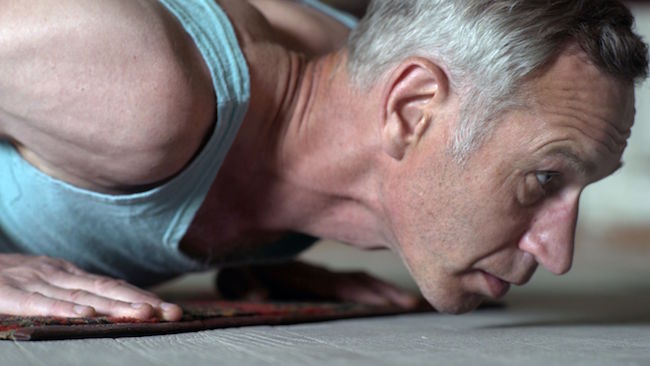
Ieva Epnere. “Potom” (“Later”, still from the video)
Do you do the filming yourself?
There are times when I do, like with the Pyramiden piece, but for the latest larger-scale video works, I work in an excellent partnership with the camera operator Baiba Kļava. Our first project together was Renunciation, after which I understood that I want to work with her again. Baiba has a very good sense of lighting, and she can very precisely perceive what I want to achieve in each work. It is great luck if you can find ‘your’ camera operator – one who is not only talented but also a nice person. Baiba and I are perfectly suited for one another – except for our difference in height. We’ve had several mix-ups because of that, especially in the context of Sea of Living Memories. There were times when we had discussed the next shot, I look through the camera to see what it will look like, and then Baiba films it... but afterwards, I notice that there’s something ‘off ’ with the proportions. Only later did we discover the reason – she’s almost a whole head shorter than I.

Ieva Epnere. “Potom” (“Later”, still from the video)
When you’re working, is it improvisation, or a very structured process?
Each time is different. In the case of Potom, there was a storyboard. Of course, the sequence changed according to the conditions. One minute the light is just right, so we go there – we’ll do this part later – and so on. I doubt that a male camera operator would go along with that. They have to do everything according to plan. But I can’t. I like an intuitive process; I think that’s what separates artists from directors. Because sometimes that which leads you to stray away from your plan is what brings the real moment and the right shot. I’ve spoken with several female video artists, including Jumana Manna, who also agree that, in the end, they prefer female camera operators. Somewhere in the subconsciousness of men lies the conviction that they know ‘how things should be done’. Men behind the camera want to rule the set. But overall, an ideal filming team is composed of me, Baiba, and the sound mixer. Lighting doesn’t interest me – I prefer natural lighting – although there have been times when additional lighting has been necessary. In the making of Potom this applied to only one scene – when the officers and sailors were gathered in the large hall. I wanted a pale, scattered light.
Why are you so fascinated by video art? You studied textile art, after all.
It’s the process; it’s the same as weaving. You weave the story into the work. There’s the gathering of material, the research period, and then you have to check all of the facts (which is very important to me). Afterwards, you can build your own version, but the framework must be true. And I really like to communicate with people; I find it enjoyable.
You’ve mentioned Sea of Living Memories several times. It’s a very private work – a research study in which your family makes up one of the main points of reference.
I must admit that it’s difficult to speak about something that was made such a long time ago. The emotions and excitement that had come over me at the time are no longer pertinent. If I try to place myself back in that time and situation, and think about why I did it… It was a set of various coincidences that resulted in this work. In 2014, the annexation of Crimea took place. I myself come from Liepāja – my father is a former Soviet military officer, a Russian from Siberia, while my mother is Latvian. A banal and classic story: the love between a Russian navy officer and a Latvian nurse. After the events in Crimea, my father and I got into some heated debates. In truth, we can no longer speak about politics with one another – it leads to a deadlock that then lasts for several months. I had just given birth to my second daughter, and I was freaking out. It seemed that... everything is coming to an end, and Latvia would be next. I probably wasn’t the only one who was being tortured by such thoughts. We even had our children registered on our passports, just in case. The annexation of Crimea was the trigger for the creation of this work. Suddenly, childhood memories and reflections about our relatively recent past rushed over me – for instance, how I, as a small child, once proudly walked on the deck of a warship, the nail of my little finger lacquered with nail polish… A strange feeling came over me. All around me are my friends, real Latvians who come from Latvian families, but I was the other side of the coin – I was of mixed nationality. And in the background, there was always the sense that the Russians are ‘the bad guys’... On the one hand, I can agree with this sentiment, but on the other... everything is not exactly black and white. All of this pent-up emotion was amassing in me... And then came the offer to make an exhibition for Art in General in New York. At first, I doubted if anyone would even understand this story. But later – when I heard the questions that people were asking about the piece, I realised that people outside of Latvia knew nothing about us and our history; I understood that it is important to talk about such topics. Since the exhibition still continues to travel to other venues after that first showing, I assume that it has somehow ‘clicked’ with people.
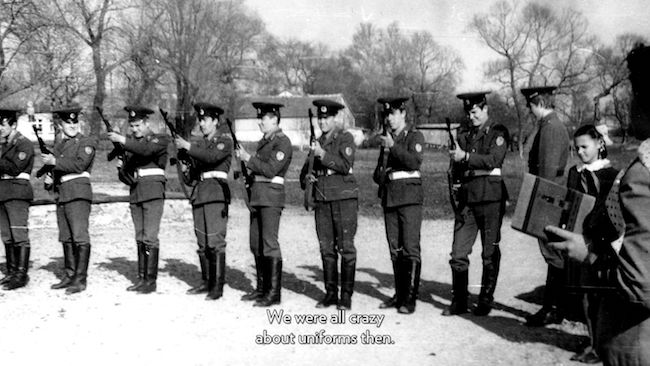
The Sea of Living Memories is a multidisciplinary phenomenon – a film, documentary video narratives, a tapestry, a photographic series… and sometimes these individual parts are displayed as a stand-alone work.
My initial idea was to make just one video work/film in which fictional and documentary stories would interweave. But while doing research for the project, I began to travel along the coast of the Baltic Sea, starting from Liepāja and up to Pāvilosta, listening to people’s stories about life in the border zone (the westernmost edge of the USSR – Ed.) There were families whose history was much like mine – the parents being of differing nationalities, one of whom had come to Latvia during their military service and then stayed here, creating a family with a Latvian wife or husband. There were many stories, and I could have continued to keep on filming them forever, but the exhibition’s deadline was approaching and I had to stop at some point. Unfortunately, several vivid stories were left out of the exhibition, and eventually, together with the exhibition’s curator, Zane Onckule, we decided on a final count of six separate documentary stories.
Unlike the central work, the 20-minute video Potom is actually fiction based on factual events.
There came a moment when I started thinking about my dad, who is eighty years old now. He is far from being the only one in his shoes – a retired former military man who stayed in Latvia because he had established a family here. According to unofficial data, around 14,000 former soviet military personnel currently live in Latvia. Many of them are physically here, but mentally, they are still there – in Russia or other parts of the former Soviet Union. They are, in some sense, lost. The deeper I delved into this, the clearer it became that this was a topic for a separate piece of work in which the main character would be like the symbol designating an alien – they don’t carry the passport for this country, and their non-citizen’s passport is neither here nor there. They have chosen to have that kind of a passport for a variety of reasons – one of which is for ease of travel to see their relatives in the land of their birth, while others are afraid of not being able to pass the naturalisation test – but regardless, they have given away their voice, their right to vote... It was immediately clear to me that the New Riga Theater actor Ģirts Krūmiņš could play this character. He can perfectly portray the role of a ghost – something that both is and and isn’t present at the same time. After meeting with him, I also realised that there was no need for text. Girts was able to bring the story to life without it.
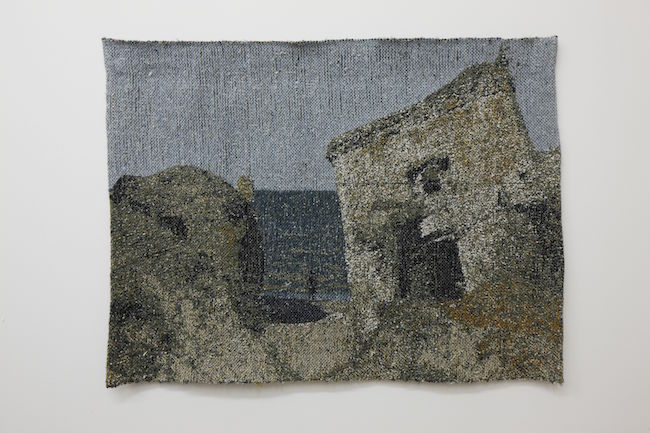
Ieva Epnere. Sea of Living Memories. Tapestry. Photo: Ansis Starks
One of the elements in the work is a tapestry that you wove. What drove you to go back to weaving?
It was an internal need to do something with my own hands, to return to a physical medium/ material (similarly, I only take pictures with an analog camera). In making a film, you may be completely ‘inside’ the process, yet there isn’t this sense of being able to feel the material with your fingertips. And when thinking about the title of the work – the sea of living memories – one sees waves, many layers... The work of weaving brings an impressive amount of historical baggage with it. In addition, it was a kind of therapy, a process in which to think. The weaving took a whole month. I had set the following timetable: weave during the day, edit film in the evenings. The weaving process helped me to structure the work as a whole. It was all executed very intuitively. I didn’t know if the tapestry would fit in or not, but I felt like it was needed. In the film, there’s a scene in which you see the Northern Fort and a person – a non-citizen, a member of the military, a symbol of the occupation (I’m open to a variety of interpretations for this image). The fragile human figure is between two powers – the sea and concrete. I was convinced that this was the scene that should also appear in the tapestry.
How does the series of photographs of starfish and corals fit into this story?
Those whose parents have ‘gone to sea’ will immediately understand what it is. When the seafarers would come back to shore, they always brought back a souvenir, such as a piece of whale tooth. Not to mention the corals – I have cabinets full of corals both in the countryside and in Liepāja. Good thing nobody threw them out. Those photographs are like a universe of memories from which these ‘trophies’ then emerge.
There are a several coded symbols in this work – and at first they’re hard to spot. For example, the colour of the walls.
It is the colour of the camel hair underwear that both scuba divers and sailors on submarines wear. I got it from my Dad – a moth-eaten underwear set that had been given to him by a buddy. He wasn’t a scuba diver himself, but in the military, they all hung out together and gave each other such gifts.
Has your father seen this work?
Parts of it. He didn’t come to the exhibition at kim? in Riga. I’ve shown it to him on the computer. He liked the documentary stories – he knows some of the people personally. He likes it when I talk about it, but my father sees everything quite differently. It’s like nostalgia for him. And perhaps his understanding of what was important to me in this work is different than mine.
